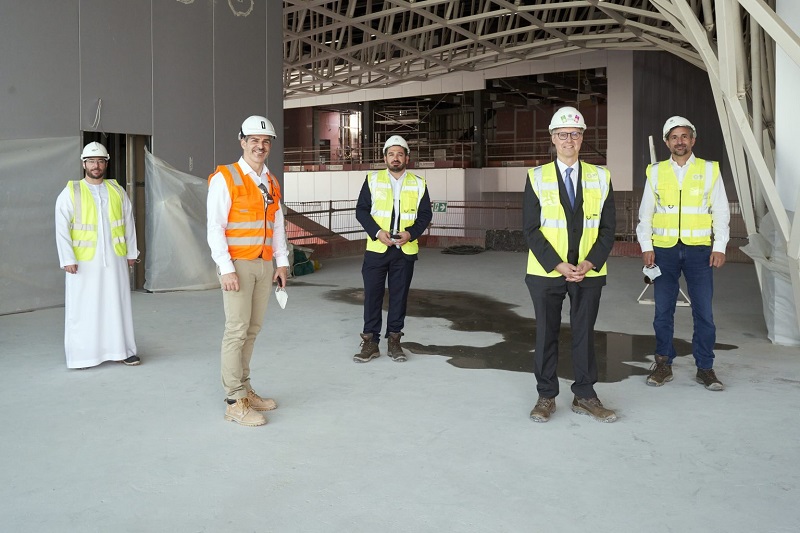With eight months to go until Expo 2020 Dubai opens on 1 October 2021, structural work on the German Pavilion site is almost finished, bringing the Federal Republic of Germany one key step closer to the completion of its showcase for the world exhibition.
“Reaching this stage is always a major milestone. In the past few months, we have been confronted with challenges we would never have even considered,” says Dietmar Schmitz, Commissioner General of the German Pavilion at Expo 2020 Dubai, discussing how construction has progressed during the pandemic.
“I’m deeply impressed by how everyone involved has pushed on with the structural work in such a professional and reliable manner – despite all the difficulties facing them.”
An average of 166 construction workers have been on the site every day since August 2019, clocking up around 472,000 hours as they erected Campus Germany under the supervision of construction firm Nussli Adunic.
“Campus Germany has already lived up to its name during the construction phase. The team are passionate about their work, always giving 100% and growing with the project,” says Harald Dosch, a managing partner at Nussli Adunic AG.
“I’m particularly proud of how brilliantly everyone has worked together despite the unusual circumstances,” he adds, referring to the strict hygiene and safety rules in place as part of COVID prevention measures on the Expo site.
Campus Germany in the Sustainability District
The theme of Expo 2020 Dubai, “Connecting Minds, Creating the Future”, is divided into three subthemes, each with its own district: sustainability, mobility, and opportunity. The CAMPUS GERMANY plot is in the Sustainability District. It has a prominent position on the main thoroughfare at the Expo, close to the host UAE Pavilion and Al Wasl Plaza, which forms the heart of the Expo site.
The team from Koelnmesse, who are responsible for organising and running the German Pavilion, are also delighted by how amazingly well the construction phase has gone.
“The German Pavilion is one of the first big country pavilions to have made such progress on structural work,” Gerald Böse, President and Chief Executive Officer of Koelnmesse GmbH, underlines.
“Although we’re very familiar with the architecture, having seen the blueprints, it’s quite something to witness it successfully translated into a physical building and to see how the ingenious Campus Germany idea, with its focus on sustainability, is already evident even at this early stage.”
Sustainable planning and design
The LAVA firm of architects, based in Berlin, incorporated the principle of sustainability into the pavilion right from the planning stage with a design that uses minimal components, materials and building mass to create spaces.
“In a lot of ways, the design of the German Pavilion actually makes the building itself part of the exhibition. It features examples of innovative solutions both in the design methods and the planning process but also in the spatial experience for the visitor – in terms of function, structure and technology,” explains Christian Tschersich, the architect in charge at LAVA.
An open ensemble composed of a variety of cubes houses the exhibition, at the same time enclosing a spacious atrium. The resulting central vertical void connects all the functional spaces with one another and produces a multitude of fascinating perspectives both inside and out.
Between the cubes, the pavilion’s outer shell will be more low-key and combine openable glass elements with ETFE membrane, inspired by the concept of a hybrid façade that can be opened and closed as needed.
The “breathing building” notion is one example of how the design provides an intelligent approach that takes functional requirements, ambient factors, and climatic aspects into account. The building shape and the roof atop the pavilion serve as passive energy-saving features, reducing the impact of direct sunlight and decreasing heat build-up.
The pavilion’s roof is an exhibit, illustrating the principle of the circular economy. A dynamic arrangement of 1,200 poles forms a spatial vector field and it is only through the complex interplay of the numerous linear elements that the roof’s volume is formed as the sum of its individual parts.
Sustainable interior
Now that the pavilion envelope is in place, work on the interior and the exhibition is beginning to pick up pace. Here too, the materials will mainly be sustainable, with all timber being Forest Stewardship Council (FSC) certified and innovative sustainable materials from Germany being used wherever possible.
For instance, exhibition furniture will be made of recycled insulation material and new types of man-made materials. All the pavilion’s media equipment will be rented for the duration of the Expo and fully reused afterwards.

